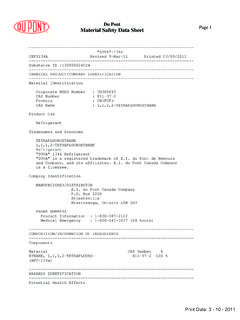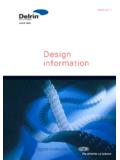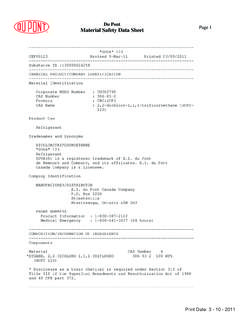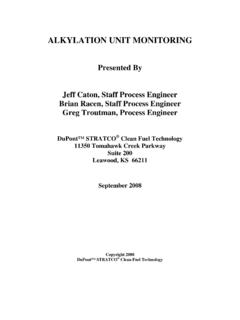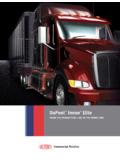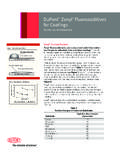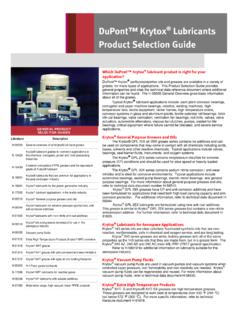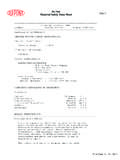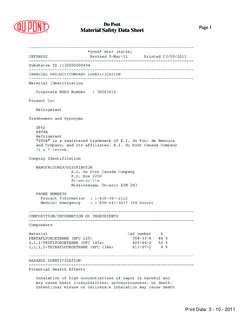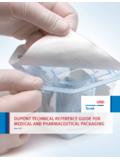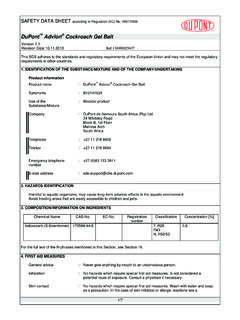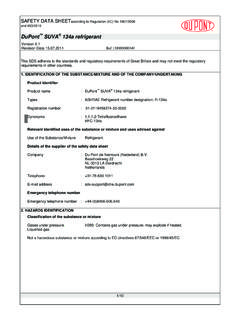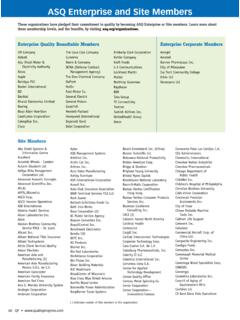Transcription of Medical Device & Diagnostic Industry Porous ... - DuPont
1 Some Medical Device manufac-turers struggle with the possibil-ity of false-positive results whenperforming sterile integrity testing(bubble-leak or dye-penetration tests)on a flexible sterile barrier system(SBS) containing Porous materials. Afalse positive can occur when a flexiblepouch containing a Porous material isbent, folded, or creased. The foldingcauses internal sheet separation of theporous can happen when apouch is folded to fit into a shelf con-tainer or is folded or bent during dis-tribution stress testing. The folding ofporous barrier materials is not recom-mended, but it is often done anyway ordifficult to avoid. Sheet separation hasbeen observed in all types of poroussheet materials currently available tothe Industry . Although not a part ofthis study, folding is also a commoncause of film failure or stress crackingin a Porous SBS.
2 A study conducted by DuPont Med-ical packaging has shown that sheetseparation does not compromise thesterile barrier of Tyvek material. Anyleakage of air or dye happens along thetransverse direction of the material, notbetween the Porous web and opposingnonporous web material as occurs ina seal failure. When performing in-tegrity tests, operators must analyzeanomalies carefully and determinewhether the seal has failed or whetherthe result is a false positive. It may benecessary to perform further investi-gation on samples that exhibit poten-tial false positives. See the sidebar Sterile Barrier Study on page 96forcomplete details of the study proce-dure. This study evaluated only Tyvek. Practices and PressuresIt is never recommended to fold flex-ible barrier materials. However, inad-vertent SBS folding can happen duringdistribution and handling.
3 Packagingsystem designs affected by cost con-straints also often contribute to mate-rials becoming folded. It is a commonpractice when designing packaging sys-tems for new products to use as manyexisting package components as possi-ble. This practice results from an im-perative to avoid small-volume pur-chases of a new, optimally sizedcomponent. And it increases the vol-ume of purchases of existing compo-nents that may not fit the new appli-cation well. The higher volume re-quirements usually result in lowerper-unit component costs. This may bea good sourcing decision, but using animproperly sized shelf box one thatrequires the flexible SBS to be foldedbefore loading can result in sheet sep-aration of the Porous material. Foldingcan also cause flex cracking of factor is that packaging en-gineers face a constant pressure to re-duce the size of the packaging space in healthcare facilities isalways at a premium.
4 Engineers arealso pressured to reduce solid-wastematerials. Factoring in this considera-tion also contributes to the need to re-duce the shelf container Effect of ISO 11607 Both testing contractors and devicemanufacturers are reporting the sheet-separation phenomenon more fre-quently than in the past. Several factorsseem to be contributing to the increasein reported instances. Probably mostimportant has been the advent of theinternational standard ISO 11607, packaging for Terminally SterilizedMedical devices . 1 The generation ofPACKAGING >> Porous Sterile BarrierIntegrity Testing:Failure AnomaliesFalse positives can occur when performing sterile integrity how to identify them can help minimize their occurrence infuture package L. LarsenCurtis L. Larsen is a consultant forDuPont Medical & Industrial Pack-aging (Wilmington, DE).
5 Medical Device & Diagnostic Industry Rintegrity tests by ASTM International,Subcommittee , Medical DevicePackaging, and the Industry s height-ened awareness of required testing ref-erenced in ISO 11607 have led to theincrease in reported Industry now has tools for in-tegrity testing that were not previous-ly available. These tests are more sen-sitive than older tests such as visualinspection and dust-drum tests. Operators are becoming more fa-miliar with the new tests and are im-plementing them more diligently. Be-fore the advent of Medical Device reg-ulations, including GMPs and the qual-ity system regulation, the Device in-dustry paid little attention topackaging. Stress testing or perfor-mance tests to evaluate the package de-sign performance were uncommonand, as a result, posttest sample anal-ysis was neither needed nor sheet-separation phenomenon,therefore, was never an operators at two large medicaldevice manufacturers and a contracttest facility have indicated that thenumber of false positives and their ownrecognition of sheet-separation phe-nomena have increased dramaticallyas they have become familiar with thetest methods.
6 What Is a False Positive?Flexible Porous sheets may separateinternally when folded because the man-ufacturing process makes the exteriorsurfaces less flexible than the process of bending the sheet caus-es deformation within the flexible innerpart of the sheet. This deformationPACKAGING >>Study ScopeAmicrobial ranking test was conducted at the request ofDuPont Medical packaging at contract test facility EthoxCorp. (Buffalo, NY) in March 2004. The purpose was toevaluate a material anomaly of sheet separation of DuPontTyvek 1073B. Sheet separation is caused when Tyvek is fold-ed to fit in the shelf carton. This phenomenon is detailed inSection 7 of the DuPont Tyvek Technical Reference Guide forMedical packaging . The testing was to determine whether aloss in filtration efficiency occurred and, therefore, whetherthe sterile barrier characteristics of the sheet were of DuPont Tyvek 1073B were split in half to sim-ulate a worst-case condition that a Tyvek- and film-peelpouch could encounter if the pouch were folded and if de-lamination within the Tyvek sheet occurred.
7 The split sheetswere subjected to testing per ASTM International F1608, Standard Test Method for Microbial Ranking of PorousPackaging Materials (Exposure Chamber Method). Allmedical styles of Tyvek are regularly tested for this attribute,and the split samples were included in a group of DocumentsDocuments used during the testing included the following: ASTM International F1608-00, Standard Test Methodfor Microbial Ranking of Porous packaging Materials(Exposure Chamber Method). 1 ASTM International F2096-01, Standard Test Methodfor Detecting Gross Leaks in Porous Medical Packagingby Internal Pressurization (Bubble Test). 2 Technical Reference Guide for Medical packaging ,H97756, rev. 10 SamplesThe samples were placed in the F1608 test apparatus sam-ple holders with the inner surface (or fuzzy side) facing thechallenge source.
8 This simulated the Tyvek orientation in apouch exhibiting this anomaly. Results and SummaryThe test results had log reduction values (LRVs) rangingfrom to There were no deviations reported fromthe Ethox Work Instructions, which provide step-by-step in-structions on how to perform testing to ASTM F1608. Summary DiscussionThe roll-average LRV values for intact sheets were as fol-lows: 1073B = , 1059B = , and 2FS = The mi-crobial barrier test results are comparable to or better thanporous barrier materials. While it is up to Device manufac-turers to set an acceptable minimum LRV based on a givenapplication, the split-1073B sample results indicate adequa-cy for providing a barrier to the ingress of contaminants thatcould compromise the sterility of the the failure mechanism (sheet separation) is the same as ob-served in the test samples, then sheet separation, pouch size,pouch configuration, and films used in the SBS (pouch) willhave no effect on sterile barrier integrity.
9 With seals intact, theside of the pouch made with Tyvek still exhibits microbialbarrier properties adequate to maintain sterility of the F1608, Standard Test Method for Microbial Ranking of PorousPackaging Materials (Exposure Chamber Method) (West Con-shohocken, PA: ASTM International: 2004). , Standard Test Method for Detecting Gross Leaks inPorous Medical packaging by Internal Pressurization (BubbleTest) (West Conshohocken, PA: ASTM International, 2004). Reference Guide for Medical packaging [online] (Wilm-ington, DE: DuPont Medical packaging , 2002); available from In-ternet: BARRIER STUDY causes tension forces within the sheetthat, when sufficiently high, can causefibers to separate. At this stage, thesefibers are the only mechanism holdingthe sheet together. The tighter the bend,the greater the forces become, until theloads become excessive.
10 The fiberstructure holding the sheet togetherthen gives and compresses on eitherside of the bend while expanding andcreating a gap between internal fibersat the bend. When the sheet is unbentor flattened out, a less-dense area, orgap, is formed in the sheet s better understand how this anoma-ly is formed, see Figures 1 and in the Porous sheet are separa-tions within the softer inner layer be-tween the outer surfaces. The originalfiber mass is still there; only the bulkdensity has Is a False Positive Found?A false positive occurs when evalu-ating the integrity of a Porous SBS bymeans of ASTM International integritytests. These tests include the following: F1929, Standard Test Method forDetecting Seal Leaks in PorousMedical packaging by Dye Pene-tration. 2 F2096, Standard Test Method forDetecting Gross Leaks in PorousMedical packaging by InternalPressurization (Bubble Test).
